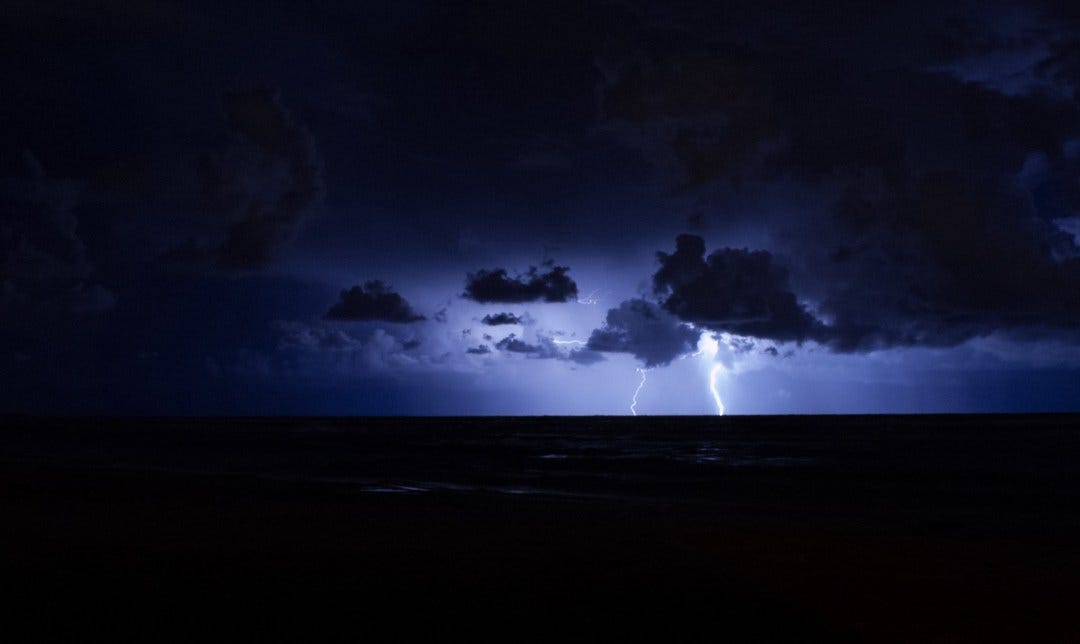Sailing in a Lightning Storm: a little close to the edge
Lightning at sea makes you pray to the gods
We’re only two days out from the Bahamas on a month long ocean crossing to Europe, when the lightning starts.
It’s midnight and the wind has been howling for hours. Now, it’s ceased almost entirely. It’s left choppy waves on top of the ocean swell and the boat is rolling and crashing in the water.
And now there’s lightning.
There’s no light pollution at sea. Zilch. And it’s a new moon so the sky is as black as possible. Except for the split second flash of the lightning, blinding us briefly before we descend back into the dark.
Occasionally a gust of wind will come from nowhere, hurling our little boat over at a horrendous angle of heel. Then another flash and a roar of thunder.
A lightning rod at sea
I’m a huge lover of lightning storms. As a child we’d walk to the clifftop near our house and watch the lightning flash over the sea. We’d stand and feel the booming sound from the heavens vibrate in our ribcages.
Even moored up in Panama I loved them. When I’d wake in the middle of the night to thunder louder than I could ever have imagined. It sounded like the whole world was imploding around us.
Panama was the only time I’d ever been afraid of it. It was the incredible, awe-inspiring sound. Like a thousand pianos crashing to earth. Like a war zone. Panama knows how to do thunder and lightning.
But sailing in a lightning storm is another level. It’s terrifying.
Because no one seems to know exactly what happens if a boat is struck by lightning. There’s no sense of predictability. No guidelines. The boat’s ten metre mast feels horrendously like a lightning rod, the highest thing for miles and miles.
Living on the edge
Weather takes on a special meaning at sea. On land, you can be snug inside your house, listening to rain lashing on the roof, the wind buffeting the windows and lightning illuminating the sky. But you’re safe.
Not so at sea.
Squalls threaten to tear sails. Wind whips up huge seas and transforms an idyllic voyage into a treacherous journey. And lightning…well, lightning is capable of anything.
One theory is that when lightning strikes a mast, the massive electrical charge will travel down to the mast step and punch a hole through the side of the boat, trying to ground itself.
No one wants a hole under the waterline.
It can fry the electrics inside, blow up radios and destroy navigational gear. The advice is to place VHF radios in the oven — a Faraday cage. But we don’t have an oven. Or a microwave. Not that anyone is in VHF range anyway.
Whatever a lightning strike would mean for us, there’s little we can do but wait and see. So I’m sat wedged in the companionway, braced against the violent motion, waiting for the next flash.
Endless waiting
Each time the thunder roars, I count the seconds. I count to see if it’s moving away. But it’s not. It seems determined to sit directly above us.
In the flashes my eyes search the sky, looking for clouds to try and gauge the size of the storm. But I can’t tell. I can’t tell which way it’s moving. And we’re not going anywhere thanks to the fickle wind.
Hours go past.
Neither of us can sleep and we still have to keep watch for ships. We constantly let out the sails and reef them again, trying to capture a little wind to move forward. It’s no use.
We are trapped in whatever this is, destined for whatever it decides.
Boom. Flash. Silence.
Please let us survive this. I pray to whichever gods of the ocean who might be listening. I don’t believe. Except when I do.
Dawn breaks and I begin to see the clouds squatting above us. Never have I experienced a lightning storm that lasts for this long. The clouds don’t even look that threatening in the half light. You wouldn’t think they could produce such phenomenal violence.
With the morning sun, the thunder and lightning subside and the fair winds return. By mid-morning, it’s a beautiful day and we’re gliding along on our way east as though nothing happened at all.
We are exhausted, utterly sleep deprived.
But I’m overjoyed. Because we have survived the latest challenge. The latest obstacle that ocean sailing has thrown at us.
And now it’s time to nap and wait for whatever comes next.
